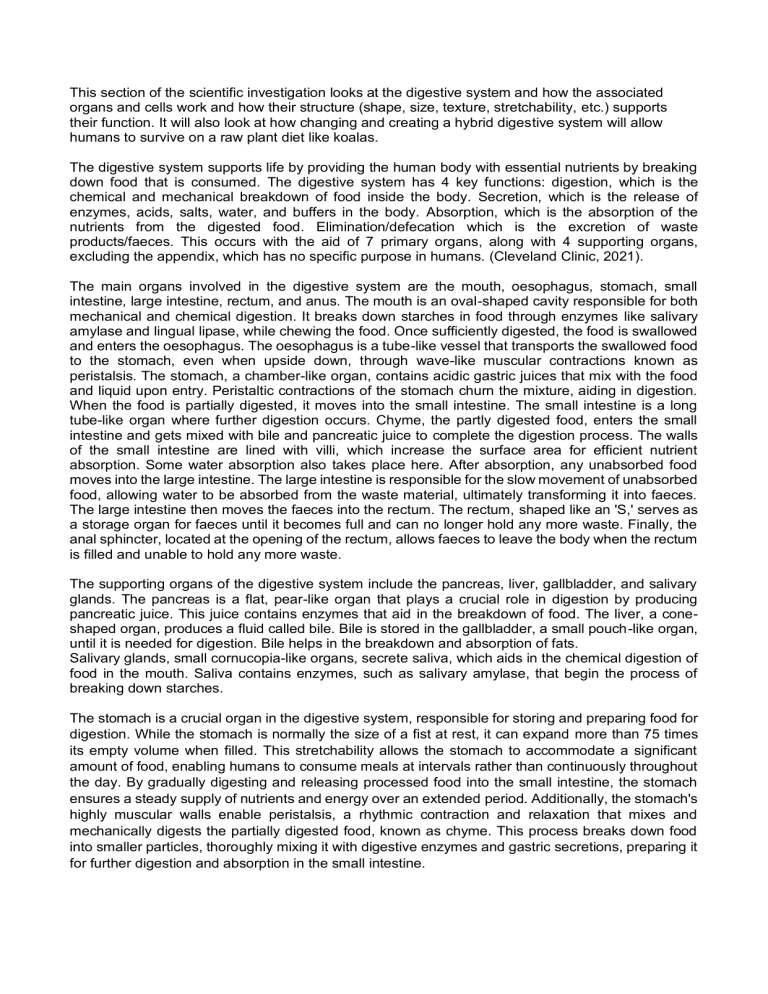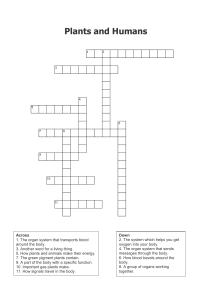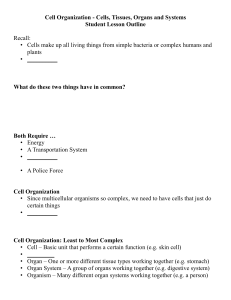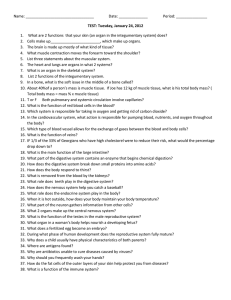
This section of the scientific investigation looks at the digestive system and how the associated organs and cells work and how their structure (shape, size, texture, stretchability, etc.) supports their function. It will also look at how changing and creating a hybrid digestive system will allow humans to survive on a raw plant diet like koalas. The digestive system supports life by providing the human body with essential nutrients by breaking down food that is consumed. The digestive system has 4 key functions: digestion, which is the chemical and mechanical breakdown of food inside the body. Secretion, which is the release of enzymes, acids, salts, water, and buffers in the body. Absorption, which is the absorption of the nutrients from the digested food. Elimination/defecation which is the excretion of waste products/faeces. This occurs with the aid of 7 primary organs, along with 4 supporting organs, excluding the appendix, which has no specific purpose in humans. (Cleveland Clinic, 2021). The main organs involved in the digestive system are the mouth, oesophagus, stomach, small intestine, large intestine, rectum, and anus. The mouth is an oval-shaped cavity responsible for both mechanical and chemical digestion. It breaks down starches in food through enzymes like salivary amylase and lingual lipase, while chewing the food. Once sufficiently digested, the food is swallowed and enters the oesophagus. The oesophagus is a tube-like vessel that transports the swallowed food to the stomach, even when upside down, through wave-like muscular contractions known as peristalsis. The stomach, a chamber-like organ, contains acidic gastric juices that mix with the food and liquid upon entry. Peristaltic contractions of the stomach churn the mixture, aiding in digestion. When the food is partially digested, it moves into the small intestine. The small intestine is a long tube-like organ where further digestion occurs. Chyme, the partly digested food, enters the small intestine and gets mixed with bile and pancreatic juice to complete the digestion process. The walls of the small intestine are lined with villi, which increase the surface area for efficient nutrient absorption. Some water absorption also takes place here. After absorption, any unabsorbed food moves into the large intestine. The large intestine is responsible for the slow movement of unabsorbed food, allowing water to be absorbed from the waste material, ultimately transforming it into faeces. The large intestine then moves the faeces into the rectum. The rectum, shaped like an 'S,' serves as a storage organ for faeces until it becomes full and can no longer hold any more waste. Finally, the anal sphincter, located at the opening of the rectum, allows faeces to leave the body when the rectum is filled and unable to hold any more waste. The supporting organs of the digestive system include the pancreas, liver, gallbladder, and salivary glands. The pancreas is a flat, pear-like organ that plays a crucial role in digestion by producing pancreatic juice. This juice contains enzymes that aid in the breakdown of food. The liver, a coneshaped organ, produces a fluid called bile. Bile is stored in the gallbladder, a small pouch-like organ, until it is needed for digestion. Bile helps in the breakdown and absorption of fats. Salivary glands, small cornucopia-like organs, secrete saliva, which aids in the chemical digestion of food in the mouth. Saliva contains enzymes, such as salivary amylase, that begin the process of breaking down starches. The stomach is a crucial organ in the digestive system, responsible for storing and preparing food for digestion. While the stomach is normally the size of a fist at rest, it can expand more than 75 times its empty volume when filled. This stretchability allows the stomach to accommodate a significant amount of food, enabling humans to consume meals at intervals rather than continuously throughout the day. By gradually digesting and releasing processed food into the small intestine, the stomach ensures a steady supply of nutrients and energy over an extended period. Additionally, the stomach's highly muscular walls enable peristalsis, a rhythmic contraction and relaxation that mixes and mechanically digests the partially digested food, known as chyme. This process breaks down food into smaller particles, thoroughly mixing it with digestive enzymes and gastric secretions, preparing it for further digestion and absorption in the small intestine. Smooth muscle cells in the stomach have an elongated, spindle-shaped structure ranging from 10 to 600 micrometres in length. This shape enables their organization into layers and bundles, facilitating simultaneous and coordinated contractions essential for efficient digestion. The elongated shape also allows for peristaltic motion, propelling food through the digestive tract, ensuring thorough mixing and exposure to digestive enzymes. The parallel arrangement of smooth muscle cells enables coordinated contractions, enabling efficient and uniform digestion. The elongated shape of the smooth muscle cells also provides them with a high degree of elasticity. This elasticity is vital for accommodating different volumes of food. When the stomach is empty, the smooth muscle cells can contract, reducing the size of the organ. Also, as food enters, the elastic smooth muscle cells can stretch and expand, accommodating larger volumes of food during meals. If the smooth muscle cells from the stomach were replaced by skeletal muscle cells, then the stomach would not be able to perform its role to the same degree of achievement. Skeletal muscle cells, as they are connected to the skeletal and nervous system, are subject to voluntary control unlike smooth muscle cells (Cleveland Clinic, 2021). Also, skeletal muscle cells have a striated arrangement, which allows it to have powerful contractions, but causes it to have a lower level of flexibility and extensibility (Heeransh Dave et al., 2022). Smooth muscle cells are more flexible than skeletal muscle cells (Physiopedia, undated). Due to skeletal muscle cells being voluntary, the stomach's ability to have regulated and coordinated and rhythmic contractions during peristalsis would be compromised. Having to consciously control these contractions while you are eating and throughout the day would be impractical and most probably impossible, as it would require constant attention, effort, and focus. Normal day-to-day function would be lost as all concentration would have to be focused on the stomach. Expansion of the stomach would also be impossible to a certain extent, as skeletal muscles do not have the same elevated level of flexibility as smooth muscle cells, which may result in a tear, causing possibly death. Unlike smooth muscle cells which have slow and sustained peristaltic contractions, skeletal muscle cells have strong, quick contractions which will impede the mechanical digestion of food inside the stomach. Thus, if smooth muscle cells were replaced by skeletal muscle cells, the stomach would not be able to maintain its optimal function. To support the adaptation of a human on a raw plant diet, a hybrid body system needs to be designed to resemble that of a koala. The key difference between the human and koala digestive systems lies in the structure and functionality of the cecum (the pouch forming the initial part of the large intestine), the appendix, as well as the composition of gut bacteria and enzymes involved in digestion found in the appendix. In koalas, the cecum performs a crucial function by fermenting and breaking down the cellulose (fibre) found in raw plants to extract and absorb nutrients. As a result, the small intestine only plays a minimal role in digesting & absorbing nutrients from food. In humans, the appendix is generally considered a vestigial organ with no apparent function that is left over from evolution (News Medical, 2019). However, in koalas, the appendix plays an active role in the digestion of cellulose. It produces bacteria, such as Cellulolytic and Lactic Acid Bacteria (Alicia Froidurot & Veronique Julliand, 2022), which are specifically designed to break down cellulose and facilitate the fermentation process within the intestines (Australian Koala Foundation, 2020). By redesigning the hybrid body system, one of the key modifications would be to enlarge the cecum. This enlargement would provide a larger fermentation chamber, allowing for increased microbial fermentation and improved nutrient extraction from plant matter. The larger cecum would facilitate the breakdown of cellulose, ensuring optimal digestion and nutrient absorption. In addition to the structural modifications, the introduction of specialized gut bacteria from the appendix would be crucial. These bacteria would possess enzymes capable of breaking down the tough plant cell walls and releasing essential nutrients that would be otherwise indigestible by humans. The presence of Cellulolytic and Lactic Acid Bacteria, like those found in koalas, would be essential to effectively break down cellulose and support fermentation within the digestive system (Wim Engels et al., 2022). These adaptations collectively mimic the specialized digestive systems observed in koalas and would enable humans to thrive on a raw plant diet. This redesigned digestive system, as seen below, would enable humans to derive sustenance from a raw plant diet. Fig.1 - Diagram of a hybrid body system that can digest raw plants. Based on a koala's digestive system and edited by Nokthor Tripura1. This section of the scientific investigation will explore how advances in immune system knowledge enabled scientists to transplant human-to-human organs successfully, how immune system knowledge led to patients not needing to take immunosuppressant drugs in the long term, and how advances in immune system knowledge allowed scientists to come closer than ever before to produce lab-grown organs. In the 1950s, the discovery of immune system rejection and Human Leukocyte Antigens (HLA) played a pivotal role in enabling human-to-human organ transplantation. Immune system rejection occurs when the body's defence mechanisms attack foreign organisms because they cannot recognize them as part of the body. The identification of this rejection process shed light on why earlier attempts at organ transplantation had failed. One key breakthrough in understanding immune system rejection was through HLAs, which are markers on the surface of cells that allow the body to recognize its own cells. These markers help the immune system distinguish between self and nonself-tissues. This discovery enabled scientists to create methods to decrease organ rejection, such as tissue typing, which was done by examining the HLAs present in a potential donor's blood sample and comparing them to those of the recipient. Through tissue typing, researchers could assess the compatibility between the two individuals. The greater the similarity in HLAs, the higher the likelihood of the recipient accepting the transplanted organ. Again, to address the challenge of 1 Stile, undated, 'Digestion: Vulture Culture', https://stileapp.com/static/CLL%20handouts/Lesson_058_handout.pdf, accessed 18th May 2023. organ rejection, scientists developed immunosuppressive drugs. These medications dampen the immune response, thereby reducing the chances of rejection (British Society for Immunology, undated). These advancements in immunological knowledge paved the way for successful humanto-human organ transplants. These breakthroughs significantly improved the survival rates of organ recipients, allowed human-to-human transplants to be made possible. There are two advances in immune system knowledge – regulatory cell therapy and chimerism – that offer the potential to eliminate or reduce the long-term need for immunosuppressant drugs. Regulatory cell therapy is a therapy that increases and enhances the regulatory cells (Regulatory T cells/Tregs are cells that suppress and control immune responses) of the recipient's body, inhibiting immunosuppression and leading to a better quality of life without the need for medication (M. Fortunata et al., 2021). The therapy involves extracting T-cells from the organ recipient's body, multiplying, and strengthening them, and then infusing them back into the body. These cells are then able to suppress the immune system's rejection of the transplanted organ, allowing the transplant recipient to live a better quality of life, free from the need for immunosuppressant drugs. Chimerism is another advancement that involves infusing donor bone marrow cells into transplant recipients. The bone marrow cells contain blood-forming stem cells, creating a chimeric immune system where both donor and recipient cells function equally within the body. This leads to tolerance of donated organs and eliminates the need for immunosuppressant drugs (National Institute of Health, 2012). Through these advancements in immune system knowledge, the longterm requirement for immunosuppressive drugs can be eliminated. One significant scientific development that has revolutionized the field of producing lab-grown organs is tissue engineering. Tissue engineering involves the use of scaffolding, which mimics the architecture and structure of organs, to create functional tissue. These scaffolds provide essential support and guidance for cells to grow, organize, and develop (Ying Zheng et al., 2017). With tissue engineering, cells can be reprogrammed and manipulated to transform into any type of cell. This means that cells can be specifically constructed to match the markers of the recipient's immune system, reducing the risk of rejection (Jingyang Guan et al., 2022). To create an environment for cell and tissue growth that closely resembles the natural conditions within the human body, scientists have turned to biomimetic materials. These materials imitate biological processes and enable the scaffolds to communicate with cells and tissues, promoting natural growth and development (Heungsoo Shin et al., 2003). The progress achieved through tissue engineering has significant implications for addressing the organ shortage crisis and ensuring that organs reach patients in need. By producing lab-grown organs, the limitations imposed by the availability of donor organs can be overcome, potentially saving countless lives. Moreover, tissue engineering offers the possibility of creating customized organs that can be tailored to individual patients, optimizing compatibility, and improving long-term outcomes. Therefore, tissue engineering represents a groundbreaking scientific advancement that has propelled the field of producing lab-grown organs. Through the use of scaffolding, cell reprogramming, and biomimetic materials, scientists have made great advancements replicating the natural growth and development of organs. This development addresses the organ shortage crisis. Fantastic effort Nokthor. Your analysis of Qs is strong, you have an ability to do research, and I think this is an extremely strong paper – well written, well researched, well analysed – it is worthy of submission into the Territory Young Scientist Awards. You only have a few things to fix up and you’re good to go. I’m very proud of you :) Very happy that you have added in the introductions for each strand. I’m really impressed with the quality of this report. Bibliography: Faiz Tuma et al., 2022, ‘Physiology, Gastrointestinal, https://www.ncbi.nlm.nih.gov/books/NBK537103/, accessed 6 May 2023. ResearchGate, 2008 – 2023, ‘Faiz Tuma’, https://www.researchgate.net/profile/Faiz-Tuma, accessed 6 May 2023. Cleveland Clinic, 2021, ‘Digestive System’, https://my.clevelandclinic.org/health/body/7041digestive-system, accessed 6 May 2023. National Institute of Diabetes and Digestive and Kidney Diseases, 2017, ‘Your Digestive System & How it Works’, https://www.niddk.nih.gov/health-information/digestive-diseases/digestive-systemhow-it-works, accessed 7 May 2023. J. Patricia & A. Dhamoon, 2022, ‘Physiology, Digestion’, https://www.ncbi.nlm.nih.gov/books/NBK544242/, accessed 7 May 2023. Visible Body, 2023, ‘Accessory Organs: Glands and Organs That Facilitate the Process of Digestion’, https://www.visiblebody.com/learn/digestive/digestive-accessory-organs, accessed 7 May 2023. National Cancer Institute, undated, ‘intestinal villi’, https://www.cancer.gov/publications/dictionaries/cancer-terms/def/intestinal-villi, accessed 7 May 2023. Lumen Learning, undated, 'The Stomach', https://courses.lumenlearning.com/atd-herkimerbiologyofaging/chapter/the-stomach/, accessed11 May 2023. Brant Hafen et al., 2022, ‘Anatomy, Smooth Muscle’, https://www.ncbi.nlm.nih.gov/books/NBK532857/, accessed 13 May 2023. Rachel Baxter M.Sc., 2022, ‘Types of Muscle Cells’, https://www.kenhub.com/en/library/anatomy/types-of-muscle-cells, accessed 13 May 2023. Cleveland Clinic, 2021, 'Skeletal Muscle', https://my.clevelandclinic.org/health/body/21787-skeletalmuscle, accessed 15 May 2023. Heeransh D. Dave et al., 2022, 'Anatomy, Skeletal Muscle', https://www.ncbi.nlm.nih.gov/books/NBK537236/, accessed 15 May 2023. Physiopedia, undated, 'Muscle: Smooth', https://www.physio-pedia.com/Muscle:_Smooth, accessed 15 May 2023. British Society for Immunology, undated, 'Transplant Immunology', https://www.immunology.org/policy-and-public-affairs/briefings-and-position-statements/transplantimmunology, accessed 16 May 2023. Susha Cheriyadath, 2019, ‘Why do humans have an Appendix’, https://www.newsmedical.net/health/Why-do-Humans-have-an-Appendix.aspx, accessed 18 May 2023. Australian Koala Foundation, 2020, ‘The Koalas’ Diet & Digestion’, https://www.savethekoala.com/about-koalas/koalas-diet-digestion/, accessed 18 May 2023. Alicia Froidurot & Veronique Julliand, 2022, ‘Cellulolytic bacteria in the intestine of large mammals’, https://www.ncbi.nlm.nih.gov/pmc/articles/PMC8865330/, accessed 18 May 2023. Wim Engels, 2022, ‘Metabolic Conversions by Lactic Acid Bacteria during Plant Protein Fermentations’, https://www.ncbi.nlm.nih.gov/pmc/articles/PMC8997616/, accessed 18 May 2023. Marta Fortunato et al., 2021, 'Regulatory Cell Therapy in Organ Transplantation: Achievements and Open Questions', https://www.ncbi.nlm.nih.gov/pmc/articles/PMC7940680/, accessed 21 May 2023. Halima Moncrieffe, undated, 'Regulatory T Cells (Tregs)', https://www.immunology.org/publicinformation/bitesized-immunology/cells/regulatory-t-cells-tregs, accessed 21 May 2023. Caroline Raffin, 2019, 'Treg cell-based therapies: challenges and perspectives', https://www.nature.com/articles/s41577-019-0232-6, accessed 21 May 2023. National Institutes of Health, 2012, 'Organ Transplants Without Life-Long Drugs', https://www.nih.gov/news-events/nih-research-matters/organ-transplants-without-life-long-drugs, accessed 21 May 2023. National Institute of Biomedical Imaging and Bioengineering, undated, 'Tissue Engineering and Regenerative Medicine', https://www.nibib.nih.gov/science-education/science-topics/tissueengineering-and-regenerative-medicine, accessed 21 May 2023. Ying Zheng et al, 2017, ' Tissue engineering toward organ-specific regeneration and disease modelling', https://www.ncbi.nlm.nih.gov/pmc/articles/PMC5939579/, accessed 21 May 2023. Heungsoo Shin et al., 2003, 'Biomimetic materials for tissue engineering', https://www.sciencedirect.com/science/article/abs/pii/S0142961203003399, accessed 21 May 2023. Jingyang Guan et al., 2022, 'Chemical reprogramming of human somatic cells to pluripotent stem cells', https://www.nature.com/articles/s41586-022-04593-5, accessed 21 May 2023. Year 8 Biological Sciences Assessment Task – Body Systems Assessment Well Above Satisfactory I can also… Scientific Understanding – Biological Sciences Explain the role of specialised cell structures in cellular function and analyse the relationship between structure and function at organ and body system levels. Design a hybrid body system that can support ONE of the following hypothetical adaptations to humans and justify why the hybrid system is able to support such an adaptation 1) a human on a raw plant diet (like cows) 2) a human who lives on land and in water 3) a human who can safely jump down from big heights (like cats) 4) a human who can control the flow of blood to particular parts of the body (like crocodiles and alligators) Above Satisfactory I can also… Keep the chosen organ from the Satisfactory column the same but replace the chosen cell from the Satisfactory column with a different cell (but having to perform the same function that the original cell performed). Hypothesize and justify if the organ would still maintain its optimal function. E.g. the organ chosen is the bladder and the original cell chosen is a smooth muscle cell that allows the bladder to contract to release urine. If the smooth muscle cells are replaced by brain cells, would the bladder be able to do what a bladder does? A labelled diagram of the hybrid body system is strongly encouraged to make any justifications and explanations clear. Satisfactory I can… COMPLETE BOTH PART A AND PART B Part A Describe the function of the chosen system in supporting life (max ¼ page) Describe the function of the organs involved in the chosen system in the human (max ½ page) Part B (about ½ to 2/3 page for both Part B Qs) Choose ONE organ in the chosen system (e.g. stomach, heart, intestines, lungs, uterus etc.) in the human body and describe how the structure (shape, size, is it muscly, is it stretchy etc.) of the organ supports the function of the organ Below Satisfactory I can… Part A Partially or does not describe the function of the chosen system in supporting life Incompletely describe the function of the organs involved in the chosen system in the human Part B Partially or does not describe how the structure of an organ supports its function Partially or does not describe how the structure of a cell supports its function Choose ONE type of cell found in the chosen organ (e.g. smooth muscle cell, goblet cell, sperm cell, red blood cell, ciliated epithelial cell etc.) in the human body and describe how the structure (shape and size) of the cell supports the function of the cell Science as a Human Endeavour Analyse scientific responses to contemporary issues Explain how different factors can influence development and application of scientific knowledge Part C - Analyse ONE scientific development that has allowed scientists to be closer than ever before to be able to produce lab grown organs, with the aim of transplanting these organs into patients who need them, thus saving lives. Part C - To prevent patients’ bodies from rejecting the transplanted organs, patients must take anti-rejection drugs for the rest of their lives. However, taking antirejection drugs in the long term causes other serious health issues in transplant patients. Analyse the further advances in the knowledge of the immune system that has led to the possibility of transplant patients not needing to take anti-rejection medications in the long term. Part C (about ¼ to ½ page) - Explain how advances in knowledge about the human immune system led to the possibility of human-to-human organ transplants in the 1950s and increased survival rates of people receiving organ transplants since the 1950s. Part C -Cannot or incompletely explain how advances in knowledge about the human immune system led to the possibility of organ transplants in the 1950s and increased survival rates of people receiving organ transplants since then. Definition of terminology used in the rubric 2023 Design – to conceive a plan for a particular purpose Analyse - examine methodically and in detail in order to explain and interpret it. Analysing goes deeper than explaining. Justify – Use evidence/data/theory/facts to support an opinion or reasoning. Examples can complement the justification but should not form the bulk of the justification. Hypothesize – Make an educated guess on a situation Describe – give an account of something Compare – note the similarity/dissimilarity of something







